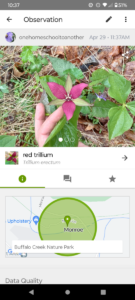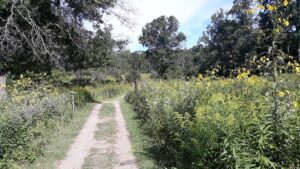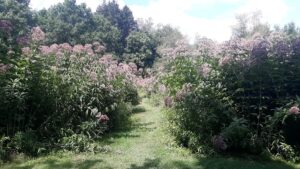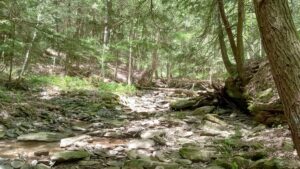
I spent years believing no flowers grew in the shade because garden centers mainly offer sun-loving ornamentals. This shady stream crossing hints at the diversity of beautiful native wildflowers that thrive in shade or part-shade conditions.
Some time ago, I read an interview* that stressed the importance of “raising our children for homecoming”–an idea that we strive to raise children who will bring the knowledge they may gain in college or trade school back home to benefit the community that raised them. I imagine that many parents desire this for their children and their communities…but how do we accomplish it?
While the most important factor is surely the warm family environment we create in our homes, perhaps there is a role that adventures can play. While we can use local history or sports to instill pride in our hometown, a strategy dear to my heart is to share with my children the natural beauty of our state. Our God is so amazing that He created many natural wonders unique to where we live. Beauty is not only found in tropical islands or towering mountain meadows–truly, God provided so much beauty right here if we can only attend to it and appreciate it.
My family loves to see the butterflies, birds, and local wildlife; birdwatching and fox sightings are so exciting–but I especially love native flora. When you study and pay attention to these, you begin to notice them everywhere; they don’t fly or run away while you get your children, and you can revisit them throughout the season. When you particularly study native plants, you appreciate the beauty, sometimes quiet and humble, sometimes majestic and awe-inspiring, of the unique creation here in our own state. These wildflowers don’t exist in every state or country; they help to connect my children to our community and see the beauty in their hometown. When you learn to recognize native plants, every drive becomes more exciting–who knows what you will spy? We have found stands of magenta New York ironweed in the Laurel Highlands, masses of trillium near Ligonier, and milkweed in a drainage ditch by the library. And as you begin to recognize and fall in love with Pennsylvania’s native plants, you will probably want to bring some of these beautiful low-maintenance plants home!

This screenshot shows the excellent search feature of the Pennsylvania Wildflowers app. This app helps you learn plant terminology to identify what you discover. While iNaturalist analyzes a photo that you take, Pennsylvania Wildflowers uses pictorial data entry and then provides you with a plant photo for confirmation.
My eyes were first opened to native plants when I stumbled across the Xerces Society’s 100 Plants to Save the Bees; here our family learned that bees fare best on native plants rather than “ornamental” plants (we observed our own garden and confirmed that the bees loved wild hyssop but practically ignored dahlias). In this book, I saw such beautiful photos of such a wide variety of wildflowers that we just had to go out and find them.
Today, I’d like to share with you a sampling of some of our favorite wildflower experiences in the past year. If you don’t know any native Pennsylvania flowers, have no fear–with a good field guide or free apps like iNaturalist and Pennsylvania Wildflowers, you can do more than just marvel at the rich clothing of the lilies of the field.
One of our early wildflower walks was at Jennings Environmental Education Center near Slippery Rock. Here we were able to see amazing prairie wildflowers and also have the opportunity to see an endangered snake species–the eastern massasauga. We actually prayed that we would see this poisonous snake and not be afraid–and our prayer was answered (Luke 1:13, 30)! We studied it from a safe place for quite a long time before lifting our gaze again to admire the goldenrods, asters, and sneezeweed in bloom during this fall hike.
Several parks now have wildflower sections. If you enjoy free summer concerts, visit the butterflies at the Hartwood Acres meadow on a Sunday this summer. Wahdo:Gwas wetlands is a short elevated trail in nearby North Park where you can also see an eagle nest. If you will be passing near Raccoon Creek State Park, a detour to their wildflower reserve will give you a chance to play hide-and-seek among towering Joe-Pye weed.

Cameras can’t do justice to wildflower sites; trails in Jennings Environmental Education Center are a mass of yellow in the fall but alight with purple blazing star flowers earlier in the season.
If you are visiting Pittsburgh and would like to see both native plants and ornamental flowers, Phipps Conservatory is a one-stop shop. The conservatory features rotating displays of flowers from around the world, a green roof, a summertime butterfly garden, and several native plants outdoors.
The Audubon Society of Western Pennsylvania (ASWP) manages several beautiful nature reserves that host guided walks, classes, and more. Buffalo Creek Nature Park along the Butler-Freeport hiking trail is a stunning spring walk along an old rail line with masses of endangered trilliums, wild geraniums, skunk cabbages, migrating birds, hidden geocaches, and more. It is just a few minutes from more beautiful woodland nature hikes at Todd Nature Reserve.
Don’t miss the ASWP’s Beechwood Farms Nature Reserve, which offers responsibly propagated native plants for your own garden. Our first trip there was such an amazing opportunity to catch, hold, and study frogs and toads that we now visit frequently. The ASWP sites offer phenomenal nature classes about wildflowers, fireflies, pollinators, birds, and more—both in person and online; we have taken many and never been disappointed (classes, often free, can be found on ASWP.org). My children love what they are learning so much that they volunteered this year to work in the native plant nursery and are starting their own business helping others connect to nature in their own backyards, . . .

Masses of Joe-Pye weed stand above our heads, creating a maze of native flowers and attracting many butterflies to Raccoon Creek State Park Wildflower Reserve. Resist the urge to collect seeds or plants from the wild–it is illegal.
. . . Which brings us back to home. Wildflowers (whether we travel to see them or welcome them into our domiciles) have so much to offer. Their gorgeous and stunning beauty, a beauty that neither King Solomon nor a supermodel can rival, reminds us of God’s provision in our lives. Their cheerful colors and amazing variety remind us of a Creator who designed all the beautiful details of our environment, made us all unique, and still cares deeply for us. Their place in our gardens reminds us of Adam’s calling to care for Eden and our calling to steward the world He gave us. Wildflowers are fleeting, blooming, and setting seeds before giving place to other beautiful species, to remind us of our temporary place in a succession of believers and our responsibility to plant the seeds of faith for the next generation. The enjoyment of spying a butterfly or hummingbird being fed by our wildflowers gives us an opportunity to once again praise the One from whom all blessings flow and who provides for every need. And attending to the many flowers unique to our part of the world provides an anchor for our children’s hearts—an anchor that will hopefully help to bring them back to the beautiful environment of their childhood, drawing them back to home.
* I regret that I cannot find this interview anywhere, but I remain grateful to it for the inspiration behind the idea of raising my children for homecoming.




